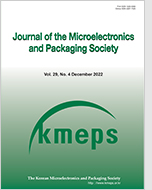SnO2/Cu(OH)2 Nanowires 전극을 이용한 전기화학적 이산화탄소 환원 특성
Tin Oxide-modulated to Cu(OH)2 Nanowires for Efficient Electrochemical Reduction of CO2 to HCOOH and CO
- 한국마이크로전자및패키징학회
- 마이크로전자 및 패키징학회지
- 제30권 제4호
-
2023.1291 - 97 (7 pages)
-
DOI : 10.6117/kmeps.2023.30.4.091
- 12

전기화학적 이산화탄소 (CO2) 환원은 CO2를 고부가가치의 탄소화합물로 전환하는 매우 유망한 방법이다. 본 논문에서는 양극 산화법과 원자층 증착법을 이용하여 전기화학적 CO2 환원용 SnO2/Cu(OH)2 나노와이어 (NWs) 전극을 합성하는 손쉬운 방법과 그 특성에 대해 보고한다. 제작된 SnO2/Cu(OH)2 NWs (-16 mA/cm2)는 -1.0 V (vs. RHE)에서Cu(OH)2 NWs (-6 mA/cm2) 대비 더 우수한 전기화학적 성능을 보였다. CO2 환원 성능을 확인해 보았을 때도 일산화탄소(CO), 포름산염 (HCOOH) 생성물에 대해 각각 29.72 %, 58.01 %의 높은 페러데이 효율 (FE)을 보였다. 본 연구는 CO2 배출로 인한 기후 변화에 대응하는 경제적이며 지속 가능한 방법을 제공할 뿐만 아니라, 전기화학적 CO2 환원용 전극 개발에 크게 기여할 것으로 예상된다.
Electrochemical (EC) CO2 reduction is a promising method to convert CO2 into valuable hydrocarbon fuels and chemicals ecofriendly. Here, we report on a facile method to synthesize surface-controlled SnO2/Cu(OH)2 nanowires (NWs) and its EC reduction of CO2 to HCOOH and CO. The SnO2/Cu(OH)2 NWs (-16 mA/cm2) showed superior electrochemical performance compared to Cu(OH)2 NWs (-6 mA/cm2) at -1.0 V (vs. RHE). SnO2/Cu(OH)2 NWs showed the maximum Faradaic efficiency for conversion to HCOOH (58.01 %) and CO (29.72 %). The optimized catalyst exhibits a high C1 Faradaic efficiency stable electrolysis for 2 h in a KHCO3 electrolyte. This study facilitates the potential for the EC reduction of CO2 to chemical fuels.
1. 서론
2. 실험방법
3. 결과 및 고찰
4. 결론
5. 감사의 말
References
(0)
(0)